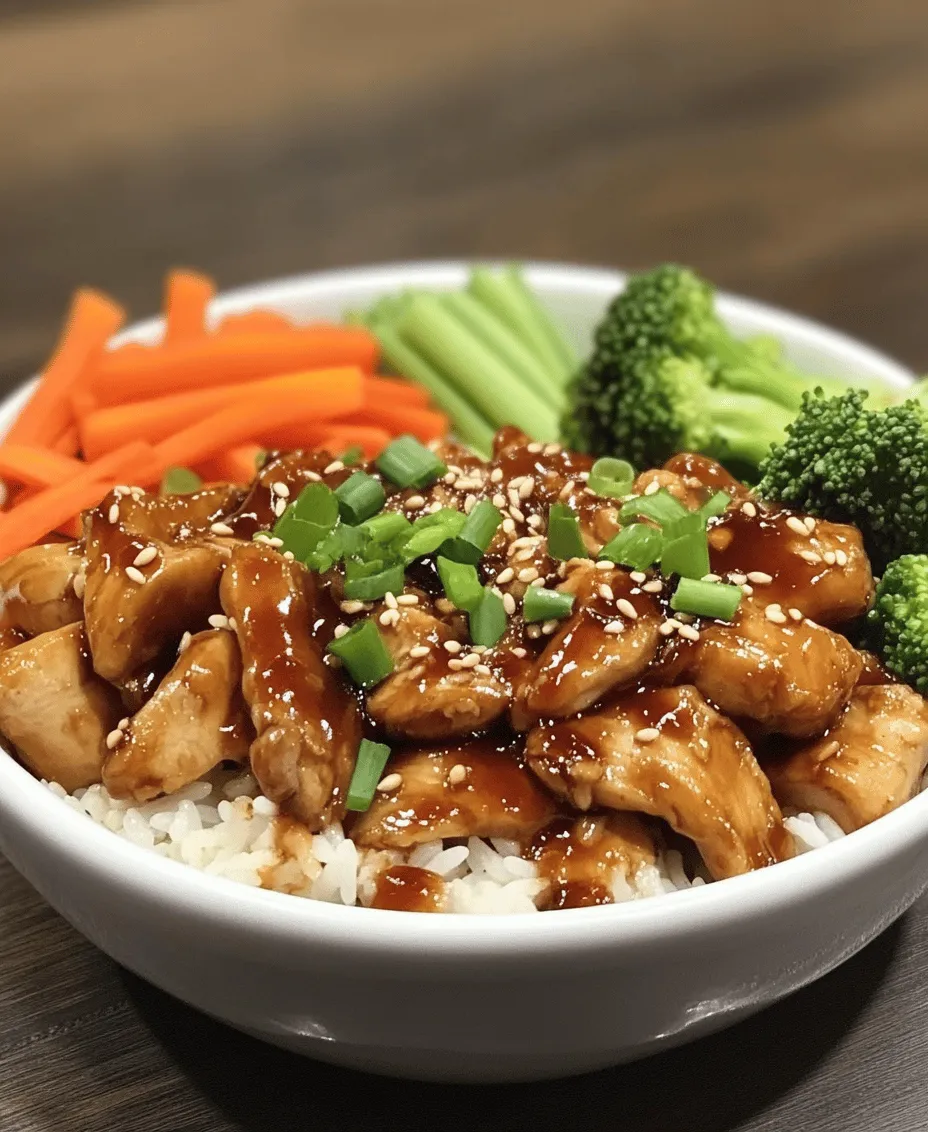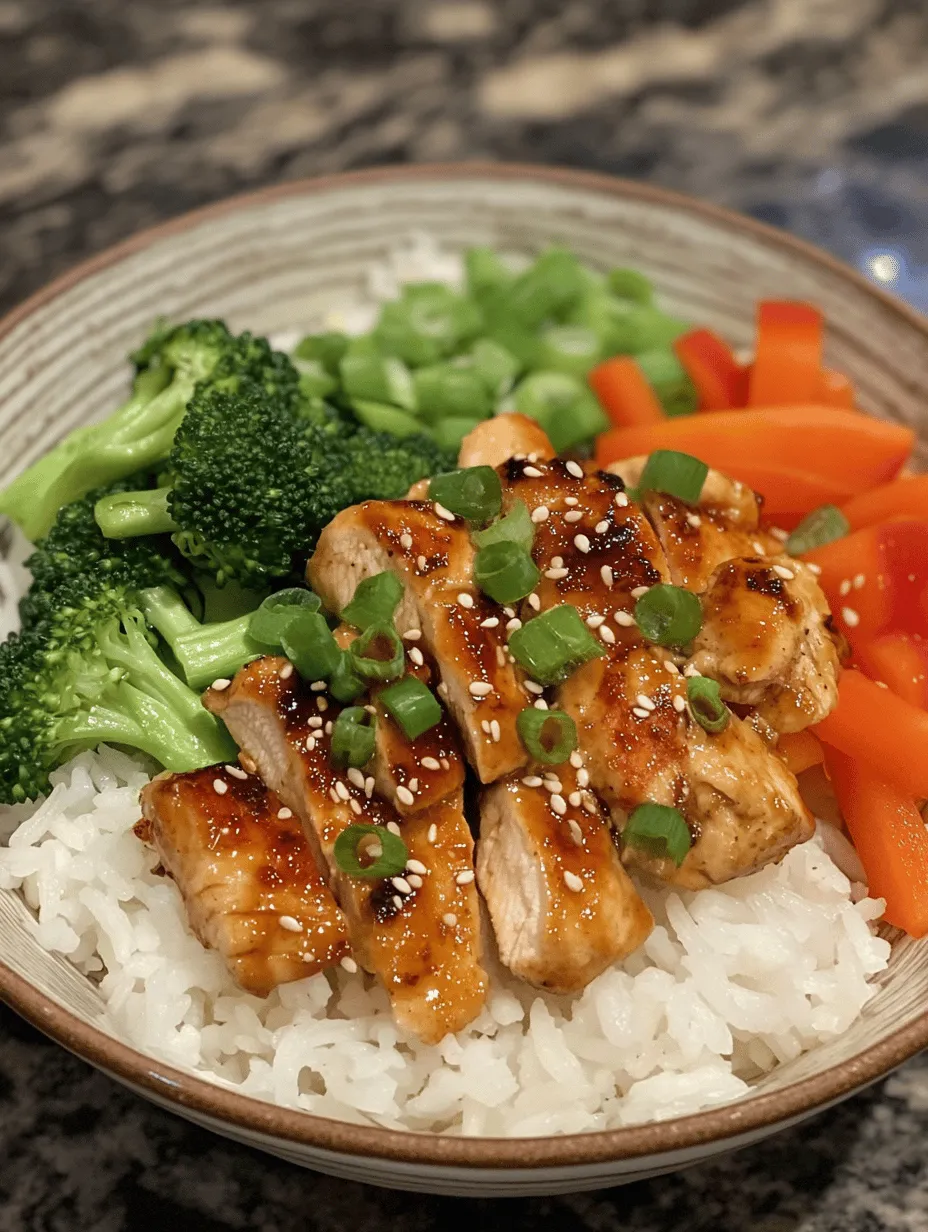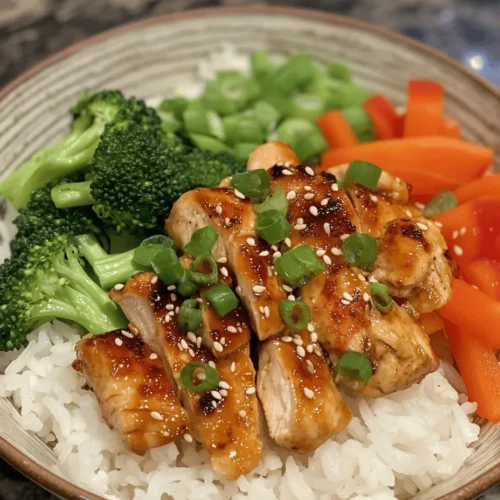Delve into a deliciously satisfying journey with our Teriyaki Chicken Rice Bowl recipe—a perfect balance of flavors and textures that will delight your taste buds. This dish features tender chicken thighs marinated in savory teriyaki sauce, complemented by vibrant vegetables and fluffy jasmine rice. In this article, we will explore the ingredients, preparation steps, and the culinary techniques that bring this dish to life. Whether you’re meal prepping for the week or looking to impress your family with a homemade meal, this recipe is sure to become a favorite.
The Allure of Teriyaki Chicken Rice Bowls
Understanding the Cultural Significance of Teriyaki
Origins of Teriyaki in Japanese Cuisine
Teriyaki, which translates to “glazed grill,” is a culinary technique deeply rooted in Japanese tradition. Dating back to the Edo period (1603-1868), it involves grilling meat or fish that has been marinated in a mixture of soy sauce, sake, and sugar. The marinade is key to creating that signature glossy finish that teriyaki is known for. While the traditional method often highlights fish, over time, chicken has emerged as a popular protein choice for this delightful cooking style.
In Japan, teriyaki dishes are often served with rice and vegetables, making for a well-rounded meal that embodies the country’s culinary philosophy of using fresh, seasonal ingredients. The balance between savory, sweet, and umami flavors is a hallmark of Japanese cuisine, and teriyaki chicken perfectly encapsulates this ethos.
Popularity in Western Food Culture
As Japanese cuisine gained popularity in the West, teriyaki chicken quickly became a staple in many households and restaurants. The dish’s appeal lies not only in its simple yet delicious flavor profile but also in its adaptability. Teriyaki chicken rice bowls can easily be customized with various vegetables, sauces, and garnishes, making them suitable for diverse palates. This versatility, combined with the accessibility of the ingredients, has solidified teriyaki chicken as a beloved dish across different cultures.
Exploring the Components of a Rice Bowl
The Role of Rice as a Base
At the heart of any rice bowl is, of course, the rice. In this Teriyaki Chicken Rice Bowl, fluffy jasmine rice serves as the perfect canvas for the other ingredients. Jasmine rice, with its slightly sticky texture and floral aroma, complements the savory flavors of the teriyaki sauce and adds a comforting element to the dish. The rice absorbs the sauce and juices from the chicken, creating a harmonious blend of flavors that enhances each bite.
The Importance of Protein and Vegetables
Protein is a crucial component of a well-balanced meal, and in this dish, the marinated chicken thighs take center stage. Chicken thighs are preferred for their tenderness and juiciness, especially when marinated, as they tend to retain moisture better than chicken breasts. This results in succulent pieces of chicken that pair beautifully with the rice and vegetables.
Speaking of vegetables, they are not just an afterthought in this rice bowl; they play a vital role in adding freshness, color, and essential nutrients. Common choices include broccoli, carrots, bell peppers, and snap peas, which provide a satisfying crunch and vibrant visual appeal. Incorporating a variety of vegetables not only enhances the flavor but also boosts the nutritional profile of the dish, making it a wholesome meal.
Ingredients Breakdown for Teriyaki Chicken Rice Bowl
To create the perfect Teriyaki Chicken Rice Bowl, you’ll need a selection of quality ingredients. Below is an overview of the essential components that contribute to the dish’s flavor and texture.
Essential Ingredients Overview
Jasmine Rice: Why it’s the Best Choice
Jasmine rice is a long-grain variety known for its aromatic qualities and slightly sticky texture when cooked. It is an ideal choice for rice bowls because it holds its shape well and complements the teriyaki chicken without overpowering it. When prepared correctly, jasmine rice can provide a light and fluffy base that enhances the overall dining experience.
Chicken Thighs: Benefits of Using Thighs Over Breasts
While chicken breasts are often touted for their leanness, chicken thighs bring a depth of flavor and juiciness that is hard to beat. Thighs contain higher fat content, which renders during cooking, resulting in tender, flavorful meat that pairs perfectly with the sweet and savory teriyaki sauce. This makes chicken thighs not only a delicious option but also a more forgiving choice for home cooks, as they are less likely to dry out compared to breasts.
Teriyaki Sauce: Store-Bought vs. Homemade
Teriyaki sauce is the star of this dish, and it can either be store-bought or homemade. Store-bought teriyaki sauces are convenient and widely available, but they can vary in flavor and quality. For those looking to customize their sauce, making it at home allows you to control the sweetness, saltiness, and overall flavor profile. A simple homemade teriyaki sauce typically consists of soy sauce, mirin (or sake), sugar, and ginger, creating a well-balanced glaze that coats the chicken beautifully.
Fresh Vegetables: Enhancing Flavor and Nutrition
Incorporating a variety of fresh vegetables not only adds color and texture to your Teriyaki Chicken Rice Bowl but also boosts its nutritional value. Vegetables like broccoli, bell peppers, and carrots offer essential vitamins and minerals, while also providing a satisfying crunch that contrasts nicely with the tender chicken and fluffy rice. Opt for seasonal vegetables to enhance flavor and freshness, and feel free to experiment with your favorites.
Garnishes: The Finishing Touches
Garnishes are the finishing touches that elevate your rice bowl. Common options include sliced green onions, sesame seeds, and pickled ginger. These garnishes not only add visual appeal but also enhance the flavor profile of the dish. The crunch of sesame seeds, the freshness of green onions, and the zing of pickled ginger create a delightful harmony that makes each bite more enjoyable.
Nutritional Insights
Balanced Nutrition in Each Serving
When prepared thoughtfully, a Teriyaki Chicken Rice Bowl can be a well-balanced meal that includes protein, carbohydrates, and essential vitamins. The combination of chicken, rice, and vegetables ensures that you are getting a variety of nutrients, including protein for muscle repair, carbohydrates for energy, and fiber for digestive health.
Health Benefits of Key Ingredients
Several key ingredients in this dish offer notable health benefits. For instance, broccoli is packed with vitamins K and C, as well as fiber, making it a powerhouse of nutrition. Ginger, often used in teriyaki sauce, is known for its anti-inflammatory properties and can aid in digestion. By incorporating these wholesome ingredients, you can enjoy a meal that is not only delicious but also nourishing.
Step-by-Step Cooking Instructions
Now that we’ve explored the ingredients and their significance, let’s dive into the cooking process. Follow these step-by-step instructions to create your Teriyaki Chicken Rice Bowl, starting with the preparation of jasmine rice.
Preparing Jasmine Rice
Rinsing and Cooking Techniques for Perfect Rice
To achieve perfectly cooked jasmine rice, start by rinsing the rice under cold water. This step removes excess starch, which can cause the rice to become gummy. Rinse the rice until the water runs clear, indicating that most of the starch has been removed.
Once rinsed, combine the rice with the appropriate amount of water in a pot. A common ratio for jasmine rice is 1 cup of rice to 1.5 cups of water. Bring the mixture to a boil over medium-high heat, then reduce the heat to low, cover the pot, and let it simmer for about 15 minutes. Avoid lifting the lid during this time, as steam is essential for cooking the rice evenly.
After 15 minutes, remove the pot from heat and let it sit, covered, for an additional 5 minutes. This resting period allows the rice to finish cooking and absorb any remaining moisture. Finally, fluff the rice with a fork to separate the grains and create a light, airy texture.
Importance of Fluffing the Rice
Fluffing the rice is a crucial step that enhances its texture. By gently separating the grains, you prevent the rice from becoming clumpy and ensure that it remains light and fluffy. This step is particularly important for a rice bowl, as it allows the rice to better absorb the flavors of the teriyaki chicken and sauce.
Marinating the Chicken
Enhancing Flavor through Marination
While the rice is cooking, it’s time to marinate the chicken. Begin by cutting the chicken thighs into bite-sized pieces and placing them in a bowl. Pour your teriyaki sauce over the chicken, making sure each piece is well-coated. Allow the chicken to marinate for at least 30 minutes, or preferably for several hours in the refrigerator. This process infuses the chicken with flavor and ensures that it remains tender during cooking.
Tips for Marinating Chicken Effectively
For optimal results, consider these tips when marinating chicken:
1. Use a Ziploc Bag: For even coating, place the chicken and marinade in a resealable bag. This allows you to easily massage the marinade into the chicken, ensuring that every piece is well-covered.
2. Marinate in the Refrigerator: Always marinate chicken in the refrigerator to prevent bacterial growth. If you’re short on time, even a 15-minute soak can enhance flavor.
3. Save Some Marinade: If you plan to use some of the marinade as a glaze for serving, set aside a portion before adding it to the raw chicken. This will ensure that it stays safe for consumption.
4. Consider Adding Aromatics: For an extra depth of flavor, consider adding minced garlic or grated ginger to your marinade. These ingredients complement the teriyaki sauce beautifully and contribute to a more complex flavor profile.
With the rice prepared and the chicken marinating, you are well on your way to creating a delicious Teriyaki Chicken Rice Bowl. In the next section, we will explore the cooking process for the chicken and vegetables, ensuring that you achieve that perfect blend of flavors that make this dish so irresistible. Stay tuned for more detailed steps on how to bring this delicious dish to life!




